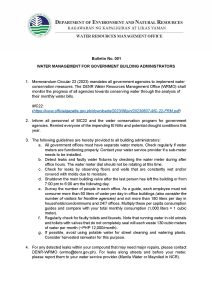The newly created Water Resources Management Office (WRMO) under the Department of Environment and Natural Resources (DENR) has released the guidelines for effective implementation of water conservation measures by all government offices, pursuant to Memorandum Circular (MC) No. 22 issued by Malacañang last month.
Through MC 22, signed by Executive Secretary Lucas Bersamin on June 7, President Ferdinand R. Marcos Jr. mandated all government agencies and instrumentalities to strictly implement water conservation measures as part of efforts to prevent a water crisis amid a looming El Niño phenomenon.
The President directed the WRMO to monitor the progress of all agencies towards conserving water through the analysis of their monthly water bills, with the aim of reducing their consumption by 10 percent.
The water conservation guidelines are contained in the first bulletin released by WRMO since its creation in April 2023 by virtue of Executive Order No. 22 issued by President Marcos.
WRMO’s primary mandate is to ensure availability and sustainable management of water resources in the country.
In its Bulletin No. 1, WRMO informed all government personnel about MC 22 and water conservation program for public offices, while reminding everyone of the “impending El Niño and potential drought conditions this year.”
The bulletin laid down the water conservation guidelines for compliance by all government offices, through their building administrators.
It provides that all agencies must have separate water meters and for them to regularly check if the meters are functioning properly. They may contact their water service provider if a sub-meter needs to be installed.
Harvested rainwater, if possible, should be used instead of potable water to clean premises or water plants.
Building administrators were reminded to monitor leaks and faulty fixtures, especially in toilets, and to be observant of floors and walls that may be constantly wet or covered with molds due to moisture.
The WRMO also recommended the shutdown of main building valves from 7:00 p.m., or after employees have completely left the office, until 6:00 a.m. the next day.
The bulletin further presented a guide in comparing total monthly consumption versus per capita consumption based on the number of employees in the office and visitors for frontline agencies.
“As a guide, each employee must not consume more than 50 liters of water per day in office buildings (also consider the number of visitors for frontline agencies) and not more than 180 liters per day in households/condominiums and 24/7 offices. Multiply these per capita consumption guides and compare with your total monthly consumption (1,000 liters = 1 cubic meter),” it stated. #
*********************













